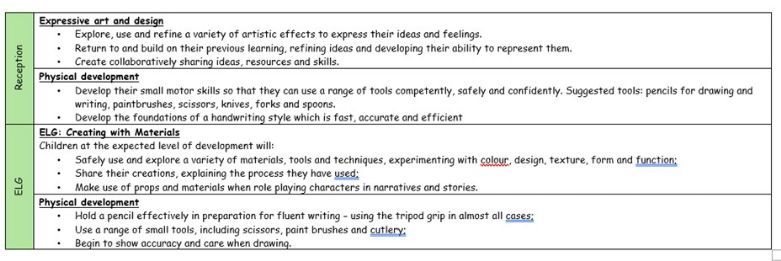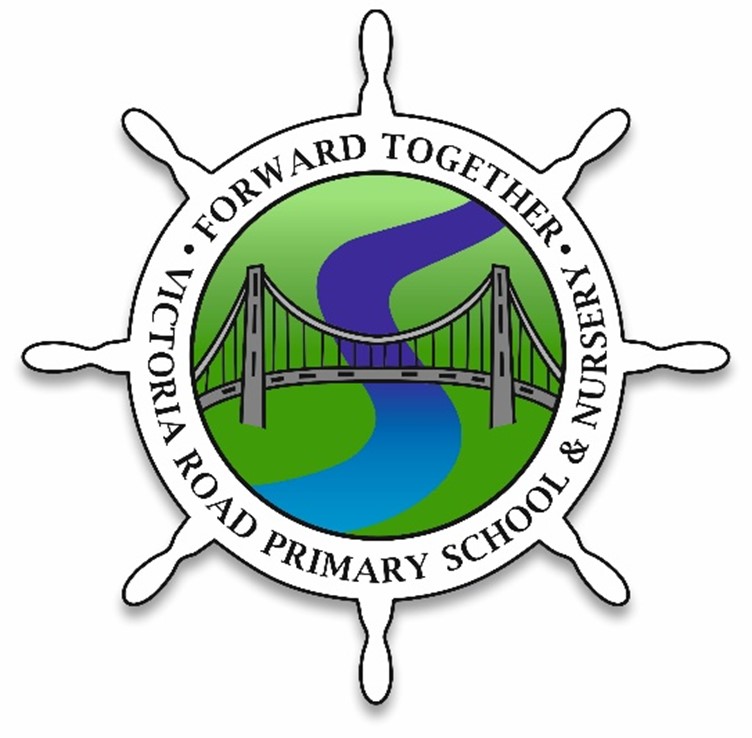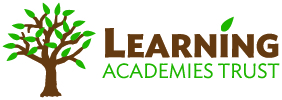Art and Design
" Art is not what you see, but what you make others see."
Principles of the Art Curriculum
Intent: Why do we teach what we teach?
The United Curriculum for Art provides all children, regardless of their background, with;
- Entitlement - Regardless of their starting point, the curriculum allows pupils to produce creative work, to explore ideas and develop the confidence to excel in a broad range of artistic techniques. All pupils will learn about artists and cultures from across history and the world.
- Coherence - Taking the National Curriculum as its starting point, the curriculum is sequenced from Early Years to key Stage 2 and beyond so that the pupils gradually develop and build their practical knowledge, including the formal elements, the use of a range of materials in two and three dimensions, and the techniques required to produce artwork. Theoretical and disciplinary knowledge is sequenced so that pupils build a deeper understanding across key stages.
- Mastery - All pupils will be explicitly taught about the formal elements - colour, form, line pattern, shape, texture and tone - and other aspects of knowledge in small steps. Pupils will revisit, develop and apply their skills with increasing technical proficiency.
- Adaptability - Our Art curriculum is designed to give teachers flexibility, allowing them to select and adapt resources for their specific context. Art is brought to live for the pupils by supplementing it with artists from their local area.
- Representation - The Art curriculum provides children with the opportunity to explore historical and contemporary artists and artworks, who represent their own and others' cultures, values and beliefs. We will explore the context in which art was produced, and consider the full breadth of human experience and expression through art.
- Education with Character - We aim to build and maintain pupils' confidence in their ability as artists to create. The curriculum will develop aspects of character such as resilience, confidence and risk-taking. Through the curriculum, pupils are given opportunities to share, reflect and learn about each other's experiences whilst recognising the things we have in common.
Implementation: What do we teach and when?
The implementation of the United Curriculum for Art & Design reflects our broader teaching and learning principles:
For Art & Design in particular,
- Content is always carefully situated within existing schemas. Every unit considers the prior knowledge that is prerequisite for that unit and builds on that knowledge to develop a deeper understanding of that concept. For example, pupils are not expected to be able to produce a representational drawing until after they have explored a range of drawing materials and have had the opportunity to experiment and create using a range of materials, techniques and processes.
- Vertical concepts are used within lessons to connect aspects of learning. In Art & Design, this is most clearly evidenced in the progression of knowledge and skills linked through the formal elements (line, tone, space, shape, form, colour, pattern and texture). These building blocks of the subject offer opportunities for pupils to develop their knowledge and understanding as well as their practical skills.
- Disciplinary knowledge is explicitly taught to pupils and carefully sequenced to ensure pupils are provided with opportunities to practice these skills throughout the curriculum. Pupils are encouraged to engage with big questions about the meaning and purpose of art, as well as exploring the concept of creativity in both a theoretical and very practical way. Our purpose is to allow our pupils to see themselves as artists by developing their innate creativity through building their confidence in knowledge, understanding and skill.
Curriculum Road Map 2024-2025
The following road map shows the units being covered by each year group.
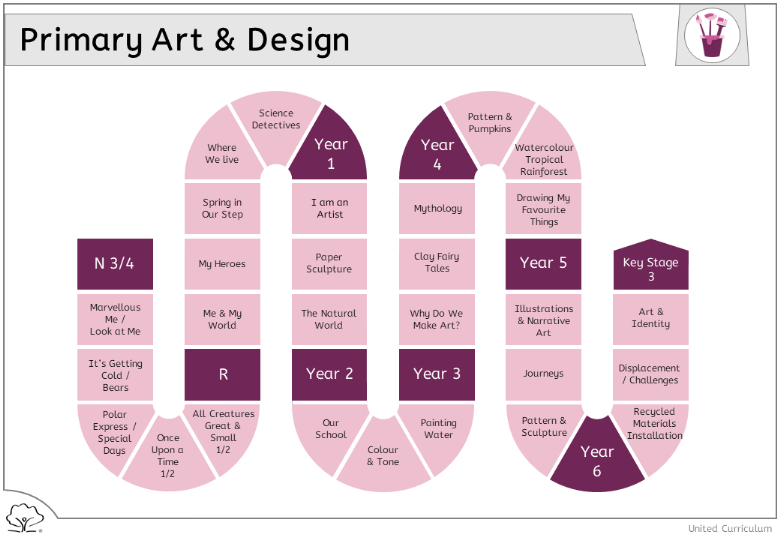
The following table shows when each unit is being taught.
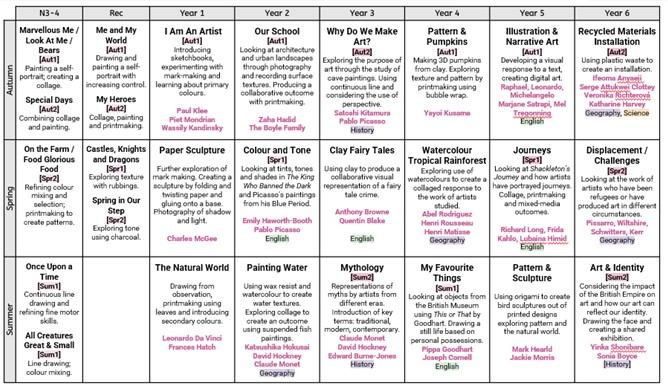
The United Curriculum for Art and Design has been adapted by considering the context of our pupils and the community.
For example:
- Pupils learn about local artists and their work, both past and present.
- In Yr1 Summer, pupils have the opportunity to explore the natural environment around their school building and record their findings using art techniques.
- In Yr2 Autumn, pupils explore their school environment and consider the work of designers and architects in relation to their own built environment.
- In Yr4 Summer and Yr6 Summer, pupils are encouraged to explore and celebrate their identity through artwork.
- In Yr5 Spring, pupils have the opportunity to record a journey they have made, during which they explore the local area through the study of maps.
Impact: How children show that they know and remember more?
The careful sequencing of the curriculum - and how concepts are gradually built over time - is the progression model. If pupils keep up with the curriculum, they make progress. Formative assessment is prioritised and is focused on whether pupils are keeping up with the curriculum.
In general this is done through:
- Use of sketchbooks and pupil-conferencing - Pupils use the same sketchbooks over multiple years, until they are complete. Sketchbooks contain a record of pupils' progress over a significant period of time. Talking to pupils about their sketchbooks allows us to assess how much of the curriculum content is secure. These conversations are used to determine whether pupils have a good understanding of the vertical concepts (practical knowledge), and if they can link recently taught content to learning from previous units.
- Formative assessment in lessons - There are opportunities in the lessons, and teachers continually adapt their lesson delivery to address misconceptions and ensure that pupils are keeping up with the content.
- Low-stakes summative assessment - We also use low-stake quizzes at the end of the unit to assess whether pupils have learnt the core knowledge for that unit. These are also used formatively, and teachers plan to fill gaps and address misconceptions before moving on.

National Curriculum
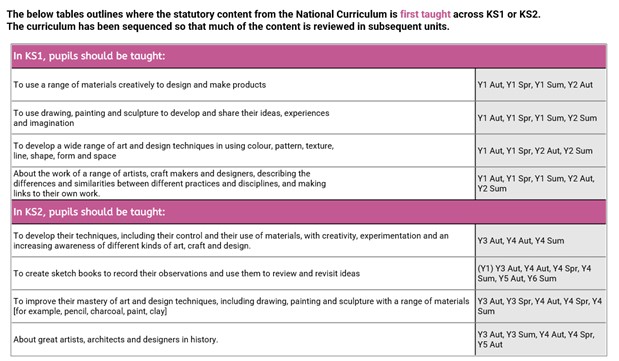
Early Years
The EYFS framework is structured very differently to the national curriculum as it is organised across seven areas of learning rather than subject areas.
Skills and knowledge developed across the EYFS form the foundations of the national curriculum subjects.
The most relevant areas of learning within the EYFS that link to art are;
- Physical development
- Expressive art and design.
Below you can see the statements taken from Development Matters areas of learning, that are prerequisites for art and match the programme of study.

